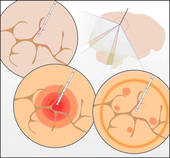Highlight
Cell targeting
Achievement/Results
IGERT trainie Jill Stukel is working with Dr. Michael Caplan and an interdisciplinary team to explore molecular recognition of specific cells. Targeting drugs to specific cells by conjugating the drug to a ligand for a cell surface receptor has potential to yield earlier detection of pathology, better localization for intervention, and fewer side effects from drug therapies. Cancer drugs can be targeted by conjugating ligand(s) specific for an over-expressed receptor with carrier entities such as polymers, thereby creating multivalent constructs and enabling more specific targeting of tumor cells relative to non-tumor cells. In tissues such as the brain, systemic drug delivery is often not possible due to the blood-brain barrier so direct injection to the tissue is required. We have developed a mathematical model of diffusive and convective transport of multivalent constructs within tissue, including the biophysics of binding to tumor and non-tumor cells, to optimize construct targeting to tumor cells in brain tissue. Predictive modeling indicates that in order to optimize attainable contrast between tumor and non-tumor tissue, a convective wash must be included subsequent to delivery to remove unbound construct. To demonstrate proof-of-concept, novel multivalent cell targeting conjugates were synthesized and characterized, and experiments were done in vitro to determine their binding ability to glioblastoma and normal healthy astrocyte (NHA) cells. To validate the results of the model, 3-D cell-gel cocultures were created to optimize delivery to achieve binding to tumor cells only. Through the integration and collaboration of the multidisciplinary fields of engineering, mathematics, chemistry, and biology, a novel approach to predict, identify, and implement a solution to a challenging problem was pursued.
Address Goals
Discovery: the development of a model for multivalent ligand binding is a fundamental advance in the application of computing to molecular recognition and has extremely broad use.
Learning: As an engineer working in a interdisciplinary biology setting, Jill is integrating engineering and modeling principles with molecular and cellular biology. This is going to be a key need in the future as more and more of the application of fundamental science to environmental and medical problems will be based on computation and modeling.






